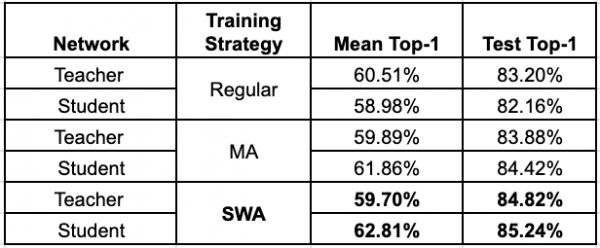带监督的一致性训练
带监督的一致性训练
作者: Sayak Paul
创建日期 2021/04/13
最后修改 2021/04/19
描述:使用一致性正则化进行训练,以提高对数据分布变化的鲁棒性。
在 Colab 中查看 • GitHub 源代码
当数据独立且同分布 (i.i.d.) 时,深度学习模型在许多图像识别任务中表现出色。但是,它们会因输入数据中细微的分布变化(如随机噪声、对比度变化和模糊)而导致性能下降。因此,自然会产生一个问题,即为什么会出现这种情况。正如在 计算机视觉中模型鲁棒性的傅里叶视角 中所讨论的,深度学习模型没有理由对这种变化具有鲁棒性。标准模型训练程序(如标准图像分类训练工作流程)不会使模型能够在训练数据形式提供的范围内之外学习。
在此示例中,我们将通过执行以下操作来训练一个图像分类模型,并在其中强制执行一种一致性:
训练一个标准的图像分类模型。 在数据集的噪声版本(使用 RandAugment 增强)上训练一个相同或更大的模型。 为此,我们将首先获取之前模型对数据集的干净图像的预测。 然后,我们将使用这些预测并训练第二个模型以匹配这些预测对相同图像的噪声变体。这与 知识蒸馏 的工作流程相同,但由于学生模型的大小相同或更大,因此此过程也被称为自训练。此整体训练工作流程的根源在于诸如 FixMatch、一致性训练的无监督数据增强 和 噪声学生训练 之类的工作。由于此训练过程鼓励模型对干净图像和噪声图像产生一致的预测,因此它通常被称为一致性训练或使用一致性正则化进行训练。虽然本示例侧重于使用一致性训练来增强模型对常见腐败的鲁棒性,但本示例也可以用作执行弱监督学习的模板。
此示例需要 TensorFlow 2.4 或更高版本,以及 TensorFlow Hub 和 TensorFlow Models,可以使用以下命令进行安装
!pip install -q tf-models-official tensorflow-addons
导入和设置
from official.vision.image_classification.augment import RandAugment from tensorflow.keras import layers import tensorflow as tf import tensorflow_addons as tfa import matplotlib.pyplot as plt tf.random.set_seed(42)
定义超参数
AUTO = tf.data.AUTOTUNE BATCH_SIZE = 128 EPOCHS = 5 CROP_TO = 72 RESIZE_TO = 96
加载 CIFAR-10 数据集
(x_train, y_train), (x_test, y_test) = tf.keras.datasets.cifar10.load_data() val_samples = 49500 new_train_x, new_y_train = x_train[: val_samples + 1], y_train[: val_samples + 1] val_x, val_y = x_train[val_samples:], y_train[val_samples:]
创建 TensorFlow Dataset 对象
# Initialize `RandAugment` object with 2 layers of # augmentation transforms and strength of 9. augmenter = RandAugment(num_layers=2, magnitude=9)
为了训练教师模型,我们将只使用两种几何增强变换:随机水平翻转和随机裁剪。
def preprocess_train(image, label, noisy=True): image = tf.image.random_flip_left_right(image) # We first resize the original image to a larger dimension # and then we take random crops from it. image = tf.image.resize(image, [RESIZE_TO, RESIZE_TO]) image = tf.image.random_crop(image, [CROP_TO, CROP_TO, 3]) if noisy: image = augmenter.distort(image) return image, label def preprocess_test(image, label): image = tf.image.resize(image, [CROP_TO, CROP_TO]) return image, label train_ds = tf.data.Dataset.from_tensor_slices((new_train_x, new_y_train)) validation_ds = tf.data.Dataset.from_tensor_slices((val_x, val_y)) test_ds = tf.data.Dataset.from_tensor_slices((x_test, y_test))
我们确保 train_clean_ds 和 train_noisy_ds 使用相同的种子进行混洗,以确保它们的顺序完全相同。这将在训练学生模型期间有所帮助。
# This dataset will be used to train the first model. train_clean_ds = ( train_ds.shuffle(BATCH_SIZE * 10, seed=42) .map(lambda x, y: (preprocess_train(x, y, noisy=False)), num_parallel_calls=AUTO) .batch(BATCH_SIZE) .prefetch(AUTO) ) # This prepares the `Dataset` object to use RandAugment. train_noisy_ds = ( train_ds.shuffle(BATCH_SIZE * 10, seed=42) .map(preprocess_train, num_parallel_calls=AUTO) .batch(BATCH_SIZE) .prefetch(AUTO) ) validation_ds = ( validation_ds.map(preprocess_test, num_parallel_calls=AUTO) .batch(BATCH_SIZE) .prefetch(AUTO) ) test_ds = ( test_ds.map(preprocess_test, num_parallel_calls=AUTO) .batch(BATCH_SIZE) .prefetch(AUTO) ) # This dataset will be used to train the second model. consistency_training_ds = tf.data.Dataset.zip((train_clean_ds, train_noisy_ds))
可视化数据集
sample_images, sample_labels = next(iter(train_clean_ds)) plt.figure(figsize=(10, 10)) for i, image in enumerate(sample_images[:9]): ax = plt.subplot(3, 3, i + 1) plt.imshow(image.numpy().astype("int")) plt.axis("off") sample_images, sample_labels = next(iter(train_noisy_ds)) plt.figure(figsize=(10, 10)) for i, image in enumerate(sample_images[:9]): ax = plt.subplot(3, 3, i + 1) plt.imshow(image.numpy().astype("int")) plt.axis("off")

定义模型构建实用程序函数
现在,我们定义模型构建实用程序。我们的模型基于 ResNet50V2 架构。
def get_training_model(num_classes=10): resnet50_v2 = tf.keras.applications.ResNet50V2( weights=None, include_top=False, input_shape=(CROP_TO, CROP_TO, 3), ) model = tf.keras.Sequential( [ layers.Input((CROP_TO, CROP_TO, 3)), layers.Rescaling(scale=1.0 / 127.5, offset=-1), resnet50_v2, layers.GlobalAveragePooling2D(), layers.Dense(num_classes), ] ) return model
为了可重复性,我们将教师网络的初始随机权重序列化。
initial_teacher_model = get_training_model() initial_teacher_model.save_weights("initial_teacher_model.h5")
训练教师模型
正如噪声学生训练中所指出的,如果教师模型使用几何集成进行训练,并且当学生模型被迫模仿它时,会导致更好的性能。最初的工作使用 随机深度 和 Dropout 来引入集成部分,但对于此示例,我们将使用 随机权重平均 (SWA),它也类似于几何集成。
# Define the callbacks. reduce_lr = tf.keras.callbacks.ReduceLROnPlateau(patience=3) early_stopping = tf.keras.callbacks.EarlyStopping( patience=10, restore_best_weights=True ) # Initialize SWA from tf-hub. SWA = tfa.optimizers.SWA # Compile and train the teacher model. teacher_model = get_training_model() teacher_model.load_weights("initial_teacher_model.h5") teacher_model.compile( # Notice that we are wrapping our optimizer within SWA optimizer=SWA(tf.keras.optimizers.Adam()), loss=tf.keras.losses.SparseCategoricalCrossentropy(from_logits=True), metrics=["accuracy"], ) history = teacher_model.fit( train_clean_ds, epochs=EPOCHS, validation_data=validation_ds, callbacks=[reduce_lr, early_stopping], ) # Evaluate the teacher model on the test set. _, acc = teacher_model.evaluate(test_ds, verbose=0) print(f"Test accuracy: {acc*100}%")
Epoch 1/5 387/387 [==============================] - 73s 78ms/step - loss: 1.7785 - accuracy: 0.3582 - val_loss: 2.0589 - val_accuracy: 0.3920 Epoch 2/5 387/387 [==============================] - 28s 71ms/step - loss: 1.2493 - accuracy: 0.5542 - val_loss: 1.4228 - val_accuracy: 0.5380 Epoch 3/5 387/387 [==============================] - 28s 73ms/step - loss: 1.0294 - accuracy: 0.6350 - val_loss: 1.4422 - val_accuracy: 0.5900 Epoch 4/5 387/387 [==============================] - 28s 73ms/step - loss: 0.8954 - accuracy: 0.6864 - val_loss: 1.2189 - val_accuracy: 0.6520 Epoch 5/5 387/387 [==============================] - 28s 73ms/step - loss: 0.7879 - accuracy: 0.7231 - val_loss: 0.9790 - val_accuracy: 0.6500 Test accuracy: 65.83999991416931%
定义自训练实用程序
对于这部分,我们将借用 此 Keras 示例 中的 Distiller 类。
# Majority of the code is taken from: # https://keras.org.cn/examples/vision/knowledge_distillation/ class SelfTrainer(tf.keras.Model): def __init__(self, student, teacher): super().__init__() self.student = student self.teacher = teacher def compile( self, optimizer, metrics, student_loss_fn, distillation_loss_fn, temperature=3, ): super().compile(optimizer=optimizer, metrics=metrics) self.student_loss_fn = student_loss_fn self.distillation_loss_fn = distillation_loss_fn self.temperature = temperature def train_step(self, data): # Since our dataset is a zip of two independent datasets, # after initially parsing them, we segregate the # respective images and labels next. clean_ds, noisy_ds = data clean_images, _ = clean_ds noisy_images, y = noisy_ds # Forward pass of teacher teacher_predictions = self.teacher(clean_images, training=False) with tf.GradientTape() as tape: # Forward pass of student student_predictions = self.student(noisy_images, training=True) # Compute losses student_loss = self.student_loss_fn(y, student_predictions) distillation_loss = self.distillation_loss_fn( tf.nn.softmax(teacher_predictions / self.temperature, axis=1), tf.nn.softmax(student_predictions / self.temperature, axis=1), ) total_loss = (student_loss + distillation_loss) / 2 # Compute gradients trainable_vars = self.student.trainable_variables gradients = tape.gradient(total_loss, trainable_vars) # Update weights self.optimizer.apply_gradients(zip(gradients, trainable_vars)) # Update the metrics configured in `compile()` self.compiled_metrics.update_state( y, tf.nn.softmax(student_predictions, axis=1) ) # Return a dict of performance results = {m.name: m.result() for m in self.metrics} results.update({"total_loss": total_loss}) return results def test_step(self, data): # During inference, we only pass a dataset consisting images and labels. x, y = data # Compute predictions y_prediction = self.student(x, training=False) # Update the metrics self.compiled_metrics.update_state(y, tf.nn.softmax(y_prediction, axis=1)) # Return a dict of performance results = {m.name: m.result() for m in self.metrics} return results
此实现中唯一的区别是计算损失的方式。与以不同方式加权蒸馏损失和学生损失不同,我们按照噪声学生训练的方式取它们的平均值。
训练学生模型
# Define the callbacks. # We are using a larger decay factor to stabilize the training. reduce_lr = tf.keras.callbacks.ReduceLROnPlateau( patience=3, factor=0.5, monitor="val_accuracy" ) early_stopping = tf.keras.callbacks.EarlyStopping( patience=10, restore_best_weights=True, monitor="val_accuracy" ) # Compile and train the student model. self_trainer = SelfTrainer(student=get_training_model(), teacher=teacher_model) self_trainer.compile( # Notice we are *not* using SWA here. optimizer="adam", metrics=["accuracy"], student_loss_fn=tf.keras.losses.SparseCategoricalCrossentropy(from_logits=True), distillation_loss_fn=tf.keras.losses.KLDivergence(), temperature=10, ) history = self_trainer.fit( consistency_training_ds, epochs=EPOCHS, validation_data=validation_ds, callbacks=[reduce_lr, early_stopping], ) # Evaluate the student model. acc = self_trainer.evaluate(test_ds, verbose=0) print(f"Test accuracy from student model: {acc*100}%")
Epoch 1/5 387/387 [==============================] - 39s 84ms/step - accuracy: 0.2112 - total_loss: 1.0629 - val_accuracy: 0.4180 Epoch 2/5 387/387 [==============================] - 32s 82ms/step - accuracy: 0.3341 - total_loss: 0.9554 - val_accuracy: 0.3900 Epoch 3/5 387/387 [==============================] - 31s 81ms/step - accuracy: 0.3873 - total_loss: 0.8852 - val_accuracy: 0.4580 Epoch 4/5 387/387 [==============================] - 31s 81ms/step - accuracy: 0.4294 - total_loss: 0.8423 - val_accuracy: 0.5660 Epoch 5/5 387/387 [==============================] - 31s 81ms/step - accuracy: 0.4547 - total_loss: 0.8093 - val_accuracy: 0.5880 Test accuracy from student model: 58.490002155303955%
评估模型的鲁棒性
评估视觉模型鲁棒性的一个标准基准是在像 ImageNet-C 和 CIFAR-10-C 这样的损坏数据集上记录它们的性能,这两个数据集都由 Benchmarking Neural Network Robustness to Common Corruptions and Perturbations 中提出。在本例中,我们将使用 CIFAR-10-C 数据集,它在 5 个不同的严重程度级别上具有 19 种不同的损坏。为了评估模型在这个数据集上的鲁棒性,我们将执行以下操作:
在最高严重程度级别上运行预训练模型,并获得 top-1 准确率。 计算平均 top-1 准确率。为了便于本例,我们将不会执行这些步骤。这就是我们只训练模型 5 个 epochs 的原因。你可以查看 这个仓库,它演示了完整的训练实验以及上述评估。下图展示了该评估的执行摘要

平均 Top-1 结果代表 CIFAR-10-C 数据集,测试 Top-1 结果代表 CIFAR-10 测试集。很明显,一致性训练不仅在增强模型鲁棒性方面具有优势,而且在提高标准测试性能方面也具有优势。
相关知识
【点云语义分割】PointMatch:弱监督三维点云语义分割的一致性训练框架
[总结] 半监督学习方法: 一致性正则化(Consistency Regularization)
半监督深度学习小结:类协同训练和一致性正则化
交叉一致性训练
[半监督学习论文笔记
[半监督学习] Interpolation consistency training for semi
训练集和测试集的分布一致性分析
一致性模型训练大提速:单GPU一小时完成数百小时工作
一致性学习的简单理解
ICLR 2020 | 对神经网络特征表达一致性、可靠性、知识盲点的评测与解释
网址: 带监督的一致性训练 https://www.mcbbbk.com/newsview258911.html
| 上一篇: 【求回顾】儿时最爱的宠物小白雪人 |
下一篇: 模型训练的一致性和稳定性:理论基 |
推荐分享

- 1养玉米蛇的危害 28694
- 2狗交配为什么会锁住?从狗狗生 7180
- 3我的狗老公李淑敏33——如何 6236
- 4豆柴犬为什么不建议养?可爱的 4637
- 5南京宠物粮食薄荷饼宠物食品包 4563
- 6中国境内禁养的十大鸟种,你知 4429
- 7湖南隆飞尔动物药业有限公司宠 4259
- 8自制狗狗辅食:棉花面纱犬的美 4257
- 9家养水獭多少钱一只正常 4212
- 10广州哪里卖宠物猫狗的选择性多 4122






